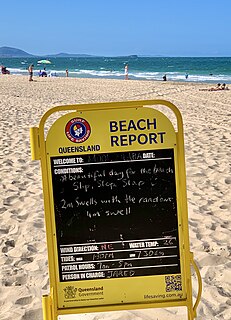 W
WSun tanning or simply tanning is the process whereby skin color is darkened or tanned. It is most often a result of exposure to ultraviolet (UV) radiation from sunlight or from artificial sources, such as a tanning lamp found in indoor tanning beds. People who deliberately tan their skin by exposure to the sun engage in a passive recreational activity of sun bathing. Some people use chemical products which can produce a tanning effect without exposure to ultraviolet radiation, known as sunless tanning.
 W
WThe Bondi Beach Cultural Landscape is a heritage-listed former Turkish baths, pavilion with dressing cubicles, dining rooms, sunbaking, shops and ballroom and now art gallery, pavilion, theatre and open air cinema located at Queen Elizabeth Drive, Bondi Beach, Waverley Municipality, Sydney, New South Wales, Australia. The pavilion was designed by Robertson and Marks, with Leith C. McCredie the architect. The Bondi Surf Life Savers' Club, erected c. 1934, was designed by Ross & Rowe. The Bondi Pavilion was designed by John Howie & Sons. The cultural landscape includes the beach itself, Bondi Surf Pavilion, Bondi Park and Bondi Surf Life Saving Club and the North Bondi Surf Club. The landscape was added to the New South Wales State Heritage Register on 23 May 2008.
 W
WBondi Sands is an Australian self tanning brand. The brand specialises in self tanners, suncare, skincare and cosmetics. The business was established in 2012 and operates in Australasia as well as the USA, UK & Europe.
 W
WThe ultraviolet radiation in sunlight has both positive and negative health effects, as it is both a principal source of vitamin D3 and a mutagen. A dietary supplement can supply vitamin D without this mutagenic effect. Vitamin D has been suggested as having a wide range of positive health effects, which include strengthening bones and possibly inhibiting the growth of some cancers. UV exposure also has positive effects for endorphin levels, and possibly for protection against multiple sclerosis. Visible sunlight to the eyes gives health benefits through its association with the timing of melatonin synthesis, maintenance of normal and robust circadian rhythms, and reduced risk of seasonal affective disorder.
 W
WIndirect DNA damage occurs when a UV-photon is absorbed in the human skin by a chromophore that does not have the ability to convert the energy into harmless heat very quickly. Molecules that do not have this ability have a long-lived excited state. This long lifetime leads to a high probability for reactions with other molecules—so-called bimolecular reactions. Melanin and DNA have extremely short excited state lifetimes in the range of a few femtoseconds (10−15s). The excited state lifetime of compounds used in sunscreens such as menthyl anthranilate, avobenzone or padimate O is 1,000 to 1,000,000 times longer than that of melanin, and therefore they may cause damage to living cells that come in contact with them.
 W
WA radiation burn is a damage to the skin or other biological tissue and organs as an effect of radiation. The radiation types of greatest concern are thermal radiation, radio frequency energy, ultraviolet light and ionizing radiation.
 W
WSkin cancers are cancers that arise from the skin. They are due to the development of abnormal cells that have the ability to invade or spread to other parts of the body. There are three main types of skin cancers: basal-cell skin cancer (BCC), squamous-cell skin cancer (SCC) and melanoma. The first two, along with a number of less common skin cancers, are known as nonmelanoma skin cancer (NMSC). Basal-cell cancer grows slowly and can damage the tissue around it but is unlikely to spread to distant areas or result in death. It often appears as a painless raised area of skin that may be shiny with small blood vessels running over it or may present as a raised area with an ulcer. Squamous-cell skin cancer is more likely to spread. It usually presents as a hard lump with a scaly top but may also form an ulcer. Melanomas are the most aggressive. Signs include a mole that has changed in size, shape, color, has irregular edges, has more than one color, is itchy or bleeds.
 W
WSlip-Slop-Slap was the iconic and internationally recognised sun protection campaign prominent in Australia and New Zealand during the 1980s. Launched by Cancer Council Victoria in 1981, the Slip! Slop! Slap! campaign featured a seagull named Sid the Seagull, who was singing and dancing to encourage people to reduce sun exposure and protect themselves against an increased risk of skin cancer. Sid had Australians slipping on long-sleeved clothing, slopping on sunscreen and slapping on a hat. This successful program was funded by public donations.
 W
WSt. Tropez is a self-tan brand, specialising in self-tan, skin finishing treatments and bronzing cosmetics. The business was established in 1996.
 W
WSun protective clothing is clothing specifically designed for sun protection and is produced from a fabric rated for its level of ultraviolet (UV) protection. A novel weave structure and denier may produce sun protective properties. In addition, some textiles and fabrics employed in the use of sun protective clothing may be pre-treated with UV-inhibiting ingredients during manufacture to enhance their effectiveness.
 W
WSunburn is a form of radiation burn that affects living tissue, such as skin, that results from an overexposure to ultraviolet (UV) radiation, usually from the Sun. Common symptoms in humans and other animals include: red or reddish skin that is hot to the touch or painful, general fatigue, and mild dizziness. Excessive UV radiation can be life-threatening in extreme cases. Excessive UV radiation is the leading cause of, primarily, non-malignant skin tumors. Sunburn is an inflammatory response in the tissue triggered by direct DNA damage by UV radiation. When the cells' DNA is overly damaged by UV radiation, type I cell-death is triggered and the tissue is replaced. Sun protective measures including sunscreen and sun protective clothing are widely accepted to prevent sunburn and some types of skin cancer. Special populations, including children, are especially susceptible to sunburn and protective measures should be used to prevent damage.
 W
WSunSmart is a not-for-profit, health promotion program in Australia that promotes a balance between the benefits and harms of sunlight exposure, most notably including vitamin D and skin cancer.
 W
WA tan line is a visually clear division on the human skin between an area of pronounced comparative paleness relative to other areas that have been suntanned by exposure to ultraviolet (UV) radiation. The source of the radiation may be the sun, or artificial UV sources such as tanning lamps. Tan lines are usually an inadvertent result of a work environment or of recreational activities, but are sometimes intentional. Many people regard visible tan lines as un-aesthetic, and seek to avoid tan lines that will be visible when regular clothes are worn.
 W
WTanning dependence or Tanorexia is a syndrome where an individual appears to have a physical or psychological dependence on sunbathing or the use of ultraviolet (UV) tanning beds. Compulsive tanning may satisfy the definition of a behavioral addiction as well.
 W
WVitamin D is a group of fat-soluble secosteroids responsible for increasing intestinal absorption of calcium, magnesium, and phosphate, and many other biological effects. In humans, the most important compounds in this group are vitamin D3 (also known as cholecalciferol) and vitamin D2 (ergocalciferol).